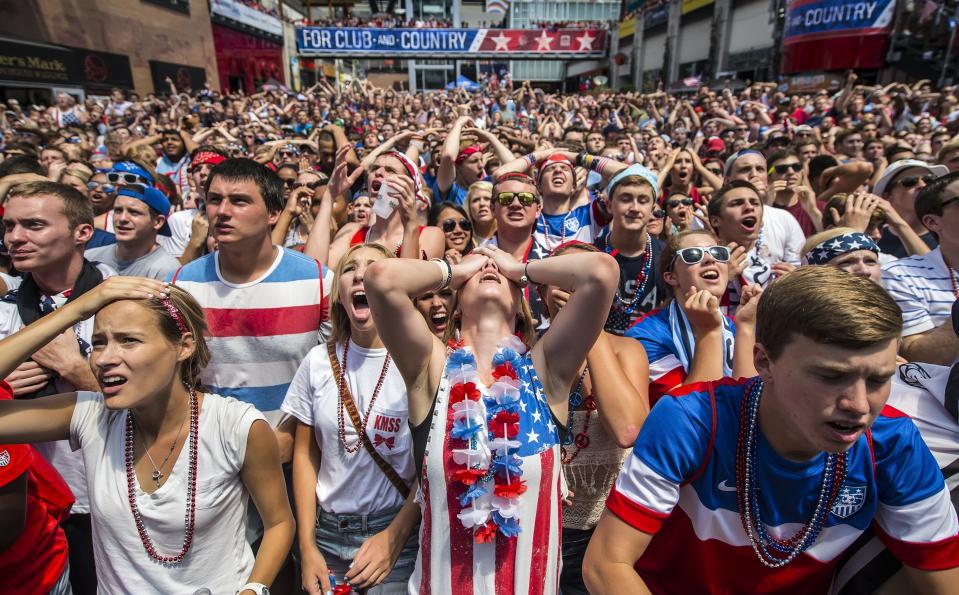In its absence, the U.S. will learn about its soccer growth at the 2018 World Cup

Every fourth summer, the American soccer community sets aside its myriad squabbles and gathers to do three things. It watches the World Cup. It roots on the United States at said World Cup. And it assesses itself in the context of that World Cup. Specifically, it judges what growth it’s made domestically and on the global stage.
This summer, it will only get to do two of those three things, courtesy of the Yanks’ ignominious absence in Russia. But that America-shaped gap at the sport’s premier event makes the introspection on how far the sport has come in the quadrennial cycle all the more acute. Because now, more than ever, soccer in America can take a quasi-referendum that isn’t muddled by jingoism or bandwagoning.
A deep and critical review of how American soccer operates, and where, more importantly, it succeeds and fails in taking young soccer players and turning the best of them into national teamers, is already underway. It was litigated ad nauseam during an election for the presidency of U.S. Soccer, even though that role has little to do with the nuts and bolts of player development.
But this World Cup will give us a chance to learn something else about American soccer: where it stands culturally.
[ Follow FC Yahoo on Twitter and Facebook ]
It is, of course, a matter of great shame that the Americans won’t be present. It’s also something of a fluke. While Jurgen Klinsmann was kept on much too long as head coach, allowed to keep punching holes into the hull of a rudderless team, and even though you can argue that Bruce Arena made late mistakes in his rescue mission, bad fortune was the primary culprit. Three unlikely results had to play out in perfect synchronicity on the final day of CONCACAF qualifying for the Americans to miss their first World Cup since 1986.
And three unlikely results did indeed play out in perfect synchronicity.
That part was just unlucky.
It’s been said to the point of great boredom that if any one of those games had swung in a slightly different way, the ongoing conversations wouldn’t have happened. And the narrative on our player development might in fact have focused on the emergence of a batch of super-promising teenagers in Christian Pulisic, Weston McKennie, Tyler Adams, Timothy Weah, Josh Sargent and Andrew Carleton.
This, more or less, is where the ongoing discord in the soccer ranks stems from. There are bad signs and good ones alike, muddying the waters to the point you can barely see through the surface, let alone make out the bottom.
But this summer will teach us something more concrete. The World Cup has offered a reliable marker on where the game stands in the mainstream, how it resonates beyond the devoted minority — if it is still that.
From 2002 through 2014, soccer pushed ever further into the American consciousness during the World Cup. To the point where it was, at last, water-cooler talk in the last edition or two. Yet how much of that growing World Cup audience was attracted by the forum for unapologetic nationalism? It’s just as hard to tell how popular the Olympics would really be if it didn’t boil down to us-versus-the-rest-of-the-world — with “us” reliably doing very well.
More data will be forthcoming. The 2018 World Cup in Russia will give us a new measurement for how popular the sport has really become. Part of the World Cup’s success is in its timing, during the early summer when the NBA and Stanley Cup Finals are already over, football season is nowhere near, and baseball isn’t particularly consequential yet.

But with the U.S. out, just how much of that audience will remain? In 2014, the World Cup final drew more than 28 million viewers to ABC, Univision and ESPN’s streaming app. Of course, the U.S. was long gone by that point. But a sizable number of viewers likely got into the tournament because they started watching U.S. games. Without that natural draw, will Americans who aren’t more than casual soccer fans be inclined to watch?
The games will also be broadcasted live from tricky time zones to the U.S. That was just as true for the 2002 World Cup in South Korea and Japan and, to a lesser extent, the 2006 and 2010 editions in Germany and South Africa, respectively. But it still doesn’t help.
FOX, the new owners of the World Cup rights after wresting them from ESPN in 2011 and eventually securing them through 2026, has indicated that it will make an enormous effort to sell this tournament. And it did a very nice job with its first event in the package, the 2015 Women’s World Cup in Canada. But there’s just no telling if the unwieldy market of sports fans will respond.
There’s no telling at all just what kind of World Cup this will be stateside. A regular one, that just so happens to be played without the fifth-best team in the region — per final CONCACAF standing — but continues the steady ascents; one that barely happened here at all; or something somewhere in between.
Whatever the answer, it will be instructive for where soccer stands in the United States in 2018.
Leander Schaerlaeckens is a Yahoo Sports soccer columnist and a sports communication lecturer at Marist College. Follow him on Twitter @LeanderAlphabet.

 Yahoo Sports
Yahoo Sports 

